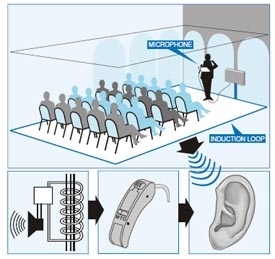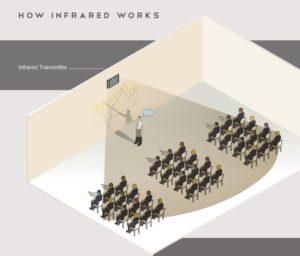Changes to the BCA (Building Code of Australia) ad the DDA (Disability Discrimination act) mean hearing augmentation services need to be provided when an inbuilt amplification system is installed in certain situations.
The ‘Deemed-To-Satisfy’ coverage requirements jumped from 15% to 95% in some floor spaces. Here is what you need to consider to ensure your spaces are compliant and accessible as possible:
What is hearing augmentation?
Hearing augmentation is a system installed to help those with a hearing impediment. There are a mix of services that can be used as a solution:
Hearing loops
Also known as an Induction or Audio loop, provides a wireless signal that can be picked up by a hearing aid when set to the Telecoil setting.
The hearing aid picks up this signal and converts it into sound instead of using the hearing aid’s built in microphone and amplifier. This provides improved speech understanding as the signal has no background noise.
Infrared System
Infrared systems broadcast sound over infrared light that is converted back to audio by infrared receivers.
Similar to the hearing loop, infrared systems only pick up the audio broadcast by the designated microphone and do not pick up as much background noise.
FM Transmitters
Audio can be broadcast via FM radio over a small area. Hearing aids can then pick this audio up directly by tuning to the corresponding frequency.
Where are hearing augmentation systems required?
Hearing augmentation is required in certain spaces that already have an inbuilt amplification system. Not every space needs one, but these are the main areas:
- Public Meeting areas for five or more people
- Emergency warning systems
- PA Systems used in shopping centres, transport facilities & public places
- Lifts
- Counters used for service provisions (with or without partitions)
- Telecommunications systems (including intercommunication systems)
- Security checkpoints
- Transport conveyances
Induction loops installed in these areas need to cover at least 80% of the floor space. Any space using IR or FM transmitter receiver systems must cover at least 95% of the floor area. There is also a minimum receiver ratio based on how many people can fit into the space:
| No. of occupants in room or space | No. of receivers required |
| Up to 500 | 1 receiver for every 25 persons or part thereof, or 2 receivers whichever is greater |
| More than 500 persons, but not more than 1,000 persons | 20 receivers, plus 1 receiver for every 33 persons or part thereof in excess of 500 persons |
| More than 1,000 persons, but not more than 2,000 persons | 35 receivers, plus 1 receiver for every 50 persons or part thereof in excess of 1,000 persons |
| More than 2,000 persons | 55 receivers, plus 1 receiver for every 100 persons or part thereof in excess of 2,000 persons |
Selecting a suitable hearing augmentation system
There are additional factors for selecting a hearing augmentation system outside of the BCA that need to be considered. These include sound reverberation, background noise, sound source distances and shapes of rooms.
The BCA does not make 100% coverage a requirement as it is possible for systems to spill over into other rooms and interfere with the augmented hearing systems in other rooms.
Induction loops can spill 10 metres over the area they are designed to cover. Infrared systems only work in direct line of sight, meaning there is less spill over but performance drops in large or oddly shaped spaces. FM transmitters cover large areas, but can be controlled with multiple frequencies.
For more details on how DIB Australia can help install your hearing augmentation system, or assistance with your custom audio visual requirements please phone DIB on (03) 9457-4800 or contact us today.


